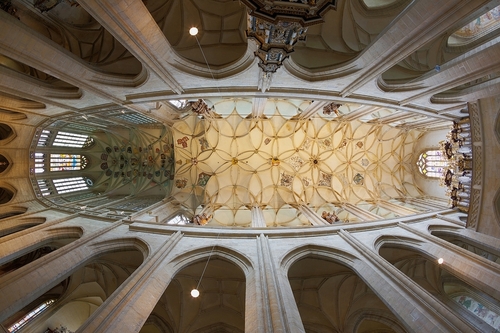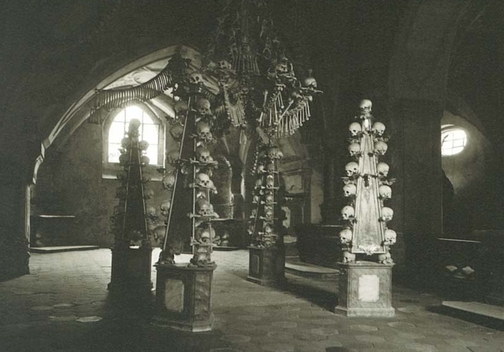15th International Workshop on Slow Positron Beam Techniques & Applications (SLOPOS-15)
important dates:
- Abstract submission deadline May 15, 2019
- Notification about abstract acceptance May 15, 2019
- Early bird registation fee deadline May 31, 2019
- SLOPOS-15 conference September 2-6, 2019
- Full paper submission deadline extended till
September 30, 2019
number of registered participants: 135
September 4, 2019, 13:30-22:00
Excursion to Kutna Hora
Kutna Hora is UNESCO heritage town located in the Central Bohemian region.
The town was established in 1142 with the settlement of Sedlec Abbey, the first Cistercian monastery in Bohemia.
Kutna Hora developed as a result of the exploitation of the silver mines.
By 1260, German miners began to mine for silver in the mountain region, which they named Kuttenberg, and which was part of the monastery property.
The name of the mountain is said to have derived from the monks' cowls (the Kutten) or from the word mining (kutani in old Czech).
Under Abbot Heidenreich, the territory greatly advanced due to the silver mines which gained importance during the economic boom of the 13th century.
The centre of Kutna Hora and Sedlec Abbey with its famous ossuary are a UNESCO World Heritage Site.
The excursion includes visiting of three most important heritages in Kutna Hora:
The Church of St. Barbara, the Church of the Assumption of Our Lady and Saint John the Baptist, and the famous Ossuary in Sedlec.
St. Barabara's church is a jewel of the late Gothic period. Construction of the church began in 1388, but because work on the church was interrupted several times,
it was not completed until 1905. The first architect was probably Johann Parler, son of Peter Parler. Work on the building was interrupted for more than 60 years during the Hussite Wars and when work resumed in 1481.
The original design was for a much larger church, perhaps twice the size of the present building. Construction, however, depended on the prosperity of the town's silver mines, which became much less productive.
So, in 1588, the three-peaked roof had been completed and a provisional wall was constructed.
A little later it was occupied by Jesuits who gradually changed the structure into Baroque style, though parts still remain in Gothic style.
The final process of repair and completion took place at the end of the 19th century, under architects J. Mocker and L. Labler.

Kutna Hora - St. Barbara's Church

Kutna Hora - St. Barbara's Church interior
Church of the Assumption of Our Lady and Saint John the Baptist , located in Sedlec was built around 1300 as one of the first High Gothic building in the Kingdom of Bohemia.
The church was a part of the Cistercians Sedlec Abbey, which was the oldest Cistercian abbey in the Czech lands founded in 1142.
The abbey was burnt down by the Hussites in 1421 and the church became a ruin for the next two centuries. In 1700 the abbot of the Sedlec Abbey Jindrich Snopek decided to rebuild the old church.
The reconstruction was conducted by the architect Pavel Ignac Bayer. After three years Bayer was replaced by Jan Blazej Santini-Aichel who had worked for the Cistercians already in Zbraslav.
He completed the reconstruction of the church in his original style called Baroque Gothic. This reconstruction was celebrated for its impressive vaulting and facade as well as for its antechamber,
which had been decorated by the statues made by Matej Vaclav Jackel. The church was consecrated in 1708. Although the church was rebuilt in the early 18th century his eastern part with side chapels,
choir and transept should have preserved its original appearance.

Kutna Hora - Church of the Assumption of Our Lady and Saint John the Baptist
Sedlec Ossuary is a a small Roman Catholic chapel containing the skeletons of between 40,000 and 70,000 people, whose bones have been artistically arranged to form decorations and furnishings for the chapel.
In 1278, Henry, the abbot of the Cistercian monastery in Sedlec, was sent to the Holy Land by King Otakar II of Bohemia. He returned with a small amount of earth he had removed from Golgotha and sprinkled it over
the abbey cemetery. The word of this pious act soon spread and the cemetery in Sedlec became a desirable burial site throughout Central Europe. In the mid 14th century, during the Black Death, and after the Hussite Wars
in the early 15th century, many thousands were buried in the abbey cemetery, so it had to be greatly enlarged. Around 1400, a Gothic church was built in the center of the cemetery with a vaulted upper level and a lower
chapel to be used as an ossuary for the mass graves unearthed during construction, or simply slated for demolition to make room for new burials. After 1511, the task of exhuming skeletons and stacking their bones
in the chapel was given to a half-blind monk of the order. Between 1703 and 1710, a new entrance was constructed to support the front wall, which was leaning outward, and the upper chapel was rebuilt. This work,
in the Czech Baroque style, was designed by Jan Santini Aichel. In 1870, Frantisek Rint, a woodcarver, was employed by the Schwarzenberg family to put the bone heaps into order, yielding a macabre result.
The signature of Rint, also executed in bone, appears on the wall near the entrance to the chapel.

Kutna Hora - Sedlec Ossuary
A dinner will be provided in the restaurant Dacicky located in the centre of Kutna Hora (18:30-20:30)









